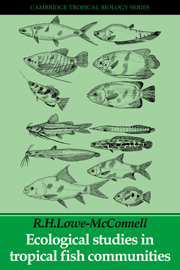Book contents
- Frontmatter
- Contents
- Preface
- Acknowledgements
- PART I INTRODUCTION
- PART II FRESHWATER STUDIES
- 2 The African fish fauna
- 3 Man-made lakes
- 4 Lacustrine fish communities in the Great Lakes of eastern Africa
- 5 Speciation: the African Great Lakes as laboratories of evolution
- 6 The Neotropical fish fauna
- 7 Far Eastern freshwater fish faunas and their distributions
- PART III MARINE FISH STUDIES
- PART IV SYNTHESES
- Appendix: Fish families in tropical waters
- References
- Index
6 - The Neotropical fish fauna
Published online by Cambridge University Press: 07 May 2010
- Frontmatter
- Contents
- Preface
- Acknowledgements
- PART I INTRODUCTION
- PART II FRESHWATER STUDIES
- 2 The African fish fauna
- 3 Man-made lakes
- 4 Lacustrine fish communities in the Great Lakes of eastern Africa
- 5 Speciation: the African Great Lakes as laboratories of evolution
- 6 The Neotropical fish fauna
- 7 Far Eastern freshwater fish faunas and their distributions
- PART III MARINE FISH STUDIES
- PART IV SYNTHESES
- Appendix: Fish families in tropical waters
- References
- Index
Summary
We have looked at riverine and lacustrine communities with African faunas subject to African conditions. How do studies in other parts of the tropics corroborate, refute, or enlarge these findings?
The Neotropical fish fauna, examples of which are shown in Fig. 6.1, is the most diversified and richest freshwater fish fauna in the world, with more than 2400 species already described. It differs from the African fauna in being derived from fewer basic stocks of fish. It lacks the rather primitive families endemic to Africa and cyprinoids and is richest in characoids and siluroids, developed by spectacular adaptive radiations initiated during South America's long isolation during the Tertiary. In the Amazon, 85% of the fishes are otophysans (compared with 54% in the Zaire), 43% are characoids, 39% are siluroids and 3% are gymnotoids. Roberts (1972) has suggested that the present Amazonian fish fauna with its large number of species might be the product of a million years of evolution from an original stock of two or three hundred founder species, but we do not know phyletic time scales. The numbers of species in families endemic to South America shown in the Appendix are only very provisional, as whole river systems have yet to be explored.
- Type
- Chapter
- Information
- Ecological Studies in Tropical Fish Communities , pp. 118 - 158Publisher: Cambridge University PressPrint publication year: 1987
- 1
- Cited by

